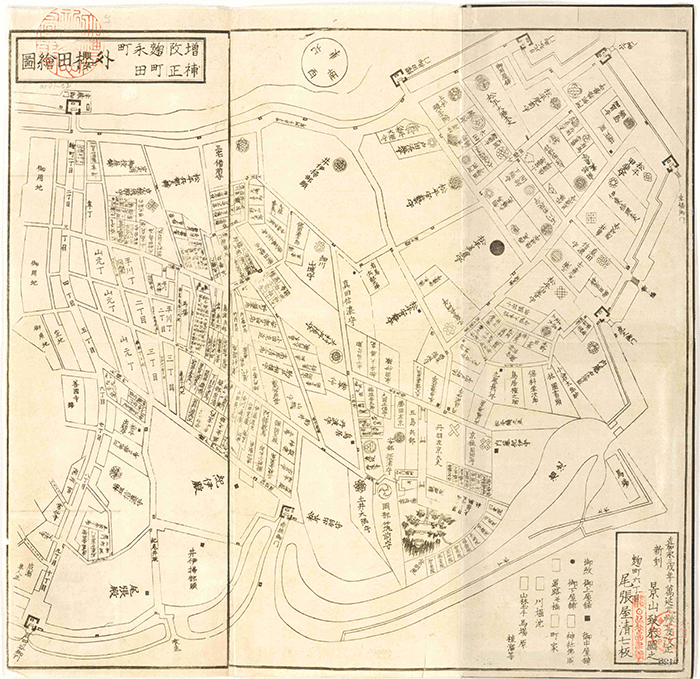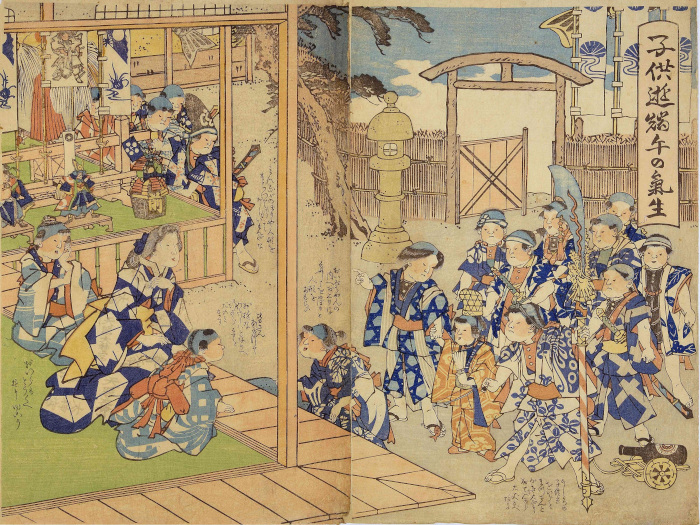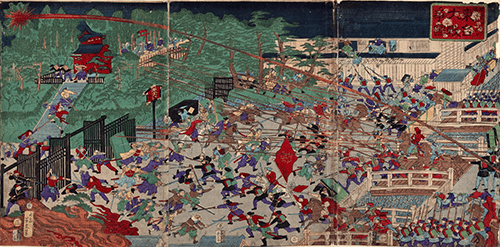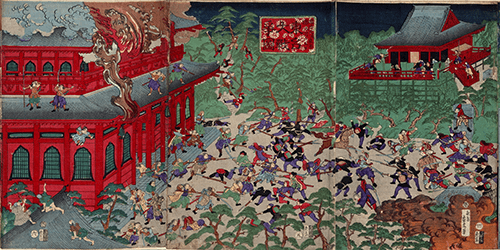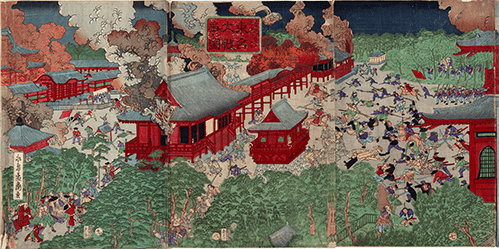Part 1. Major Incidents in Edo

In June 1853, four warships from the United States under the command of Commodore Matthew Perry arrived off the coast of Uraga. Fifteen years later, in September 1868, Japan entered a new era, Meiji. In the 15 tumultuous years between these two dates, the city of Edo experienced a variety of major incidents. Part 1 of the exhibition profiles six of these incidents: The Construction of Odaiba as part of Edo's coastal defenses, The Sakuradamon Incident that highlighted how weak the Shogunate had become, The Assassination of Heusken, an interpreter for the U.S. Consul, The Surrender of Edo Castle that marked the fall of the Shogunate, The Battle of Ueno, in which Edo itself became a battleground, and The Procession of the Emperor to Tokyo which marked the relocation of the national capital.
- 1 Perry's Arrival and the Construction of Odaiba
- 2 From the Sakuradamon Incident to Heusken's Assassination
- 3 From the Surrender of Edo Castle to the Procession of the Emperor to Tokyo
1 Perry's Arrival and the Construction of Odaiba
U.S. Commodore Perry arrived in Japan in June 1853 with demands including the official opening up of Japan to the outside world, but left again after the Shogunate requested more time to consider its response. Perry returned in the new year of 1854, and the Treaty of Peace and Amity between the Unites States and the Empire of Japan was signed in March of the same year.
Shortly after Perry's 1853 visit, work began on the construction of Odaiba (meaning gun battery) on the Shinagawa coast, as a means of strengthening Edo's coastal defenses. Eleven separate bases were planned as part of this construction, but only six were completed: numbers 1 to 3 and numbers 5 and 6, as well as Gotenyamashitadaiba at Gotenyama (later counted as number 4).
The Construction of Odaiba
1 Americans Landing at Kurihama
Kondō Marine Memorial Foundation Collection 79-1
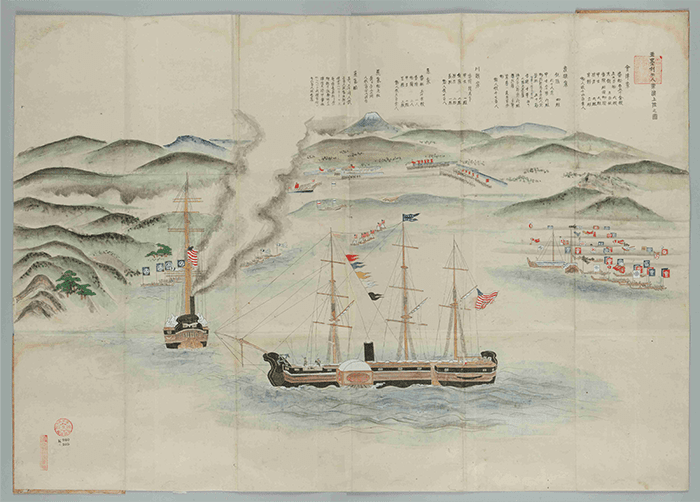
In June 1853, Commodore Matthew Perry arrived at Uraga with his four warships, seeking the opening of Japan to the outside world. Perry presented the diplomatic papers from the U.S. President. It was at the village of Kurihama, adjacent to Uraga, that Shogunate officials received the diplomatic papers. This is an illustration of the landing at Kurihama. Perry's steamships can be seen, along with the banners of the Aizu domain and others deployed for security purposes. The text above the illustration describes the size of the steamships and outlines the security measures. (78.5×111.3cm)
2 Land and Sea Defenses at Izu, Sagami, Musashi, Awa, Kazusa, and Shimousa
Kondō Marine Memorial Foundation Collection 328
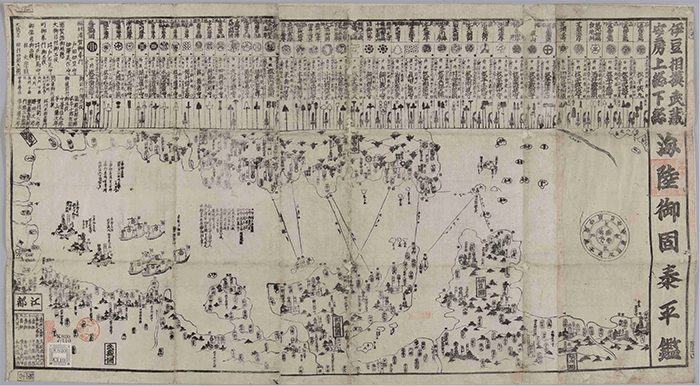
Immediately after Perry's arrival at Uraga, the Shogunate began to strengthen its defenses in Edo Bay. It assigned forces from a number of domains to guard locations such as the Sagami and Boso coasts. The upper part of this printed document provides information on each domain involved, and the figure in the lower section shows the positions they held. News of the defense of Edo Bay was circulated throughout the city of Edo in kawaraban (commercial news-sheets). (47×86cm)
3 Diary of Official Duties for Construction of Coastal Odaiba
Tokyo Shiryō Collection 6929-2
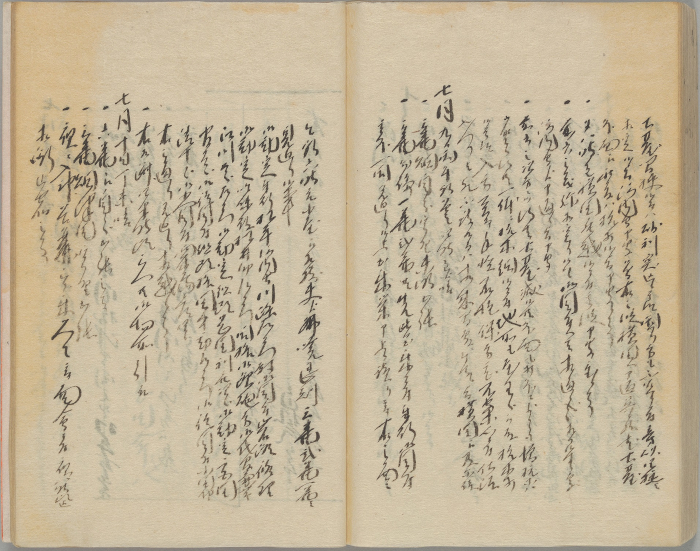
This is an extract from the diary of Takamatsu Hikosaburo, the Shogunate official in charge of the onsite construction of gun batteries, known as Odaiba. The diary covers the period between August 27, 1853, which is immediately after work began on the Number 1, 2 and 3 Odaiba, and December 22, 1854, when the final three Odaiba, Number 5, Number 6, and Gotenyamashita, were completed and handed over to the domain in charge of its security for use in its defenses. The entry displayed here, from July 9, 1854, describes Shogunate officials conducting inspections of the Number 1, 2 and 3 Odaiba after their completion. (24×17cm)
4 Specification Drawings for Odaiba in Shinagawa, Edo (4) No.3 Odaiba
Tokyo Shiryō Collection 0511-30-4
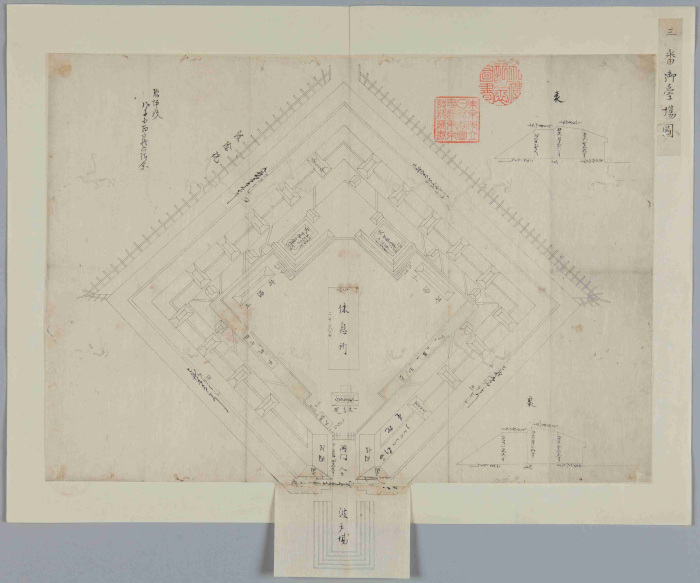
The Number 3 Odaiba gun battery was located on a site of roughly 28,100㎡, including a powder magazine and embankments for defending the battery. Breakwaters were constructed around the site both to prevent wave erosion and to stop enemy vessels from berthing here. Work on the battery began in August 1853, and in November of the following year it was handed over to the Oshi domain, which was placed in charge of its security. (34.5×40cm)
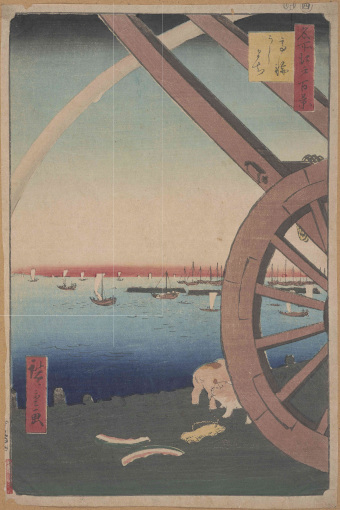
5 One Hundred Famous Views of Edo: Takanawa Ushimachi
Tokyo Shiryō Collection 0431-C7
Takanawa Ushimachi was located near the settlement of Takanawa Ookido on the Tokaido highway. In the mid 17th century, porters who used ox carts were brought to this region from Kyoto and later settled permanently, and the district became known as Ushimachi, literally "ox town." This illustration is a view of Edo bay from the coast of Ushimachi. The stone construction in the distance is an Odaiba, one of the gun batteries build for the defense of Edo. (35.2×23.6cm)
2 From the Sakuradamon Incident to Heusken's Assassination
March 1860 was the date of the Sakuradamon Incident, in which a chief minister of the Tokugawa Shogunate, Ii Naosuke, was assassinated by ronin samurais of the Mito and Satsuma domains. The assassination is said to have been prompted by the Shogunate's signing of the United States-Japan Treaty of Amity and Commerce and by the oppression of people in favor of revering the emperor and repelling foreign powers. The assassination of a top-ranking official in broad daylight severely undermined the Shogun's authority.
In December 1860, warriors opposed to foreign influence also assassinated Henry Heusken, the interpreter for U.S. Consul Townsend Harris. Heusken was confronted on his way home to the U.S. Consulate-General located in Zenpuku-ji Temple in Azabu. This was one of a series of assassinations of foreign nationals by anti-foreign forces around this time.
The Sakuradamon Incident
6 Expanded and Revised Map of Sakurada, Kojimachi, Nagatacho
Tokyo Shiryō Collection 0411-30
This map depicts the area surrounding the location of the Sakuradamon Incident. It is a revised edition issued in 1860, the year the incident took place. The upper central section is labelled Sakurada Gomon, another term for the gate of Sakuradamon (part enlarged image). The incident involved the assassination of Chief Minister Ii Naosuke during his journey of just 200 meters from his own residence to Sakuradamon. (48.5×52.5cm)
7 Illustrations of Edo Castle Exterior Gates (3) Sakurada Gomon Outer Gate
【The Important Culture Property】Tokyo Shiryō Collection 6194-2
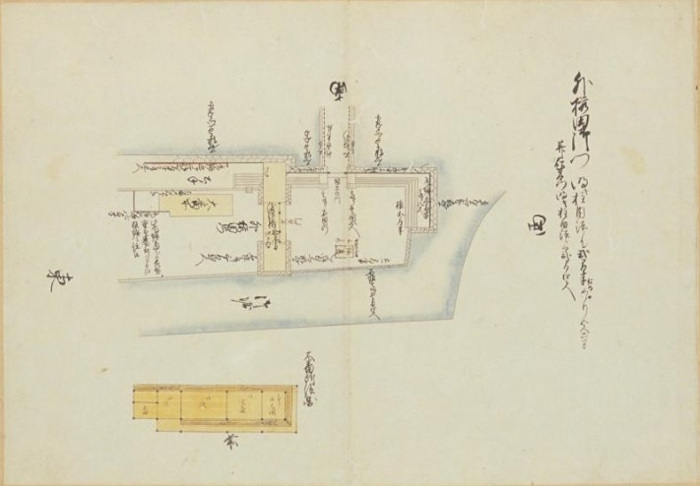
This is a ground plan of Sakuradamon, which is known for the incident of the same name. It is the third in a collection of 26 illustrations of the exterior of Edo Castle, a government-designated Important Cultural Property. Sakuradamon is a masugata construction comprising stone-walls that surrounded a square space. The pathway between the first and the second gates in the walls turned at a right angle.The Sakuradamon gate still stands today, and has been designated by the Japanese government as an Important Cultural Property.
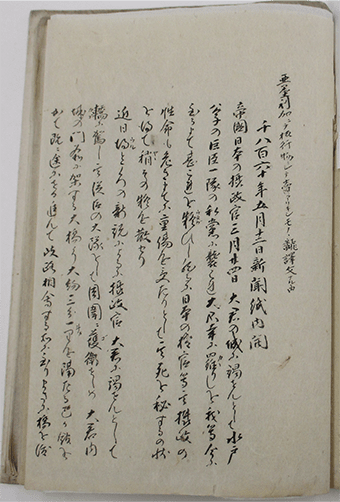
8 Sakurada Documents 2 (1860)
Collection of Special Acquisitions (from various individuals) 2518-110
This is a supplement to the scrapbook Shii no Mi Fude by Hachiya Mokitsu, essayist and retainer of the Tayasu Household. On the left page is a Japanese translation of an article on the Sakuradamon Incident from an American newspaper dated May 12, 1860. The article opens by reporting that the "Regent of the Empire of Japan" was attacked on March 24 (March 3 in the old calendar). (25.2☓18cm)
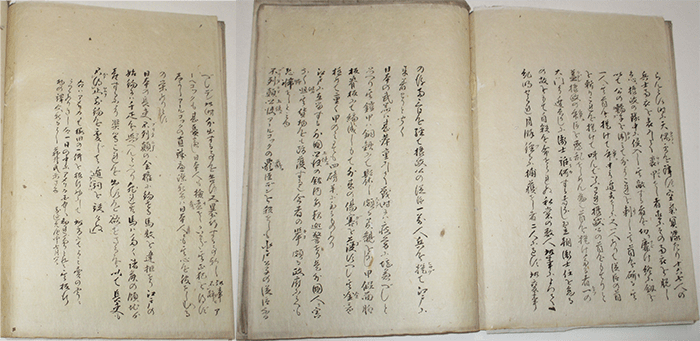
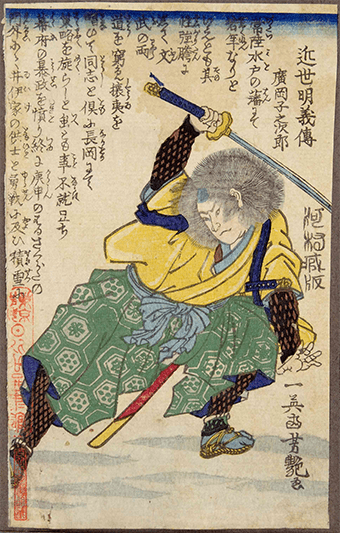
9 Righteous Men of Early Modern Times: Hirooka Nenojiro
Righteous Men of Early Modern Times: Arimura Jizaemon
Tokyo Shiryō Collection 2445-K1-5 (2)、2445-K1-6 (2)
Righteous Men of Early Modern Times (Kinsei Meigiden) is a series of ukiyo-e prints depicting ronin samurai of the Mito and Satsuma Domains who were involved in the assassination of Chief Minister Ii Naosuke.
Hirooka Nenojiro was one of the Mito Domain ronin samurai who attacked Ii outside the Sakuradamon gate.(upper image)(17.9×11.4cm)
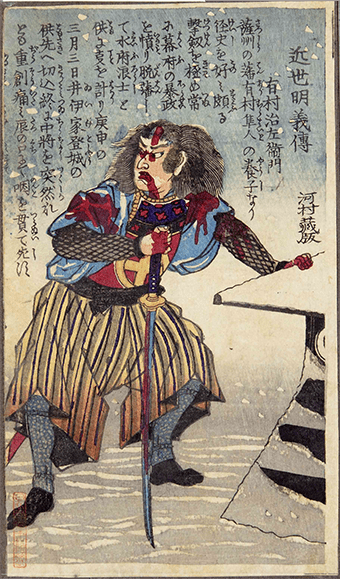
Arimura Jizaemon was the only member of the band of 18 assassins who was from the Satsuma Domain. (lower image)
(18.5×10.6cm)
The Heusken's Assassination
10 Map of Azabu in the Eastern City
Tokyo Shiryō Collection 0432-3ア
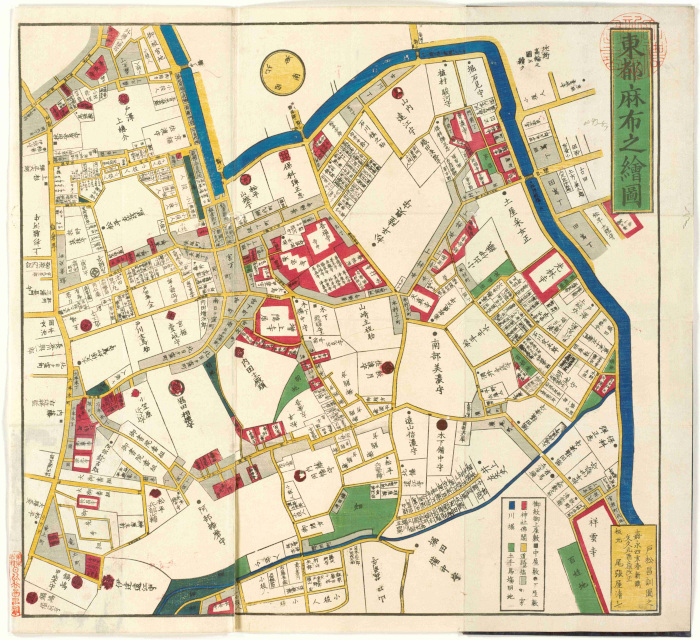
This is a map of the area around the site of the assassination of Henry Heusken, the Dutchman who was serving as interpreter for the U.S. mission in Edo. The attack itself occurred at Nakanohashi, shown in the central left of the upper portion of this map. Heusken was on his way back to his home in Zenpuku-ji Temple, which housed the U.S. mission at the time.(48.5×53cm)
11 Map and Written Report on the Calamity of Heusken, Interpreter for the United States Mission
Tokyo Shiryō Collection 697-C17
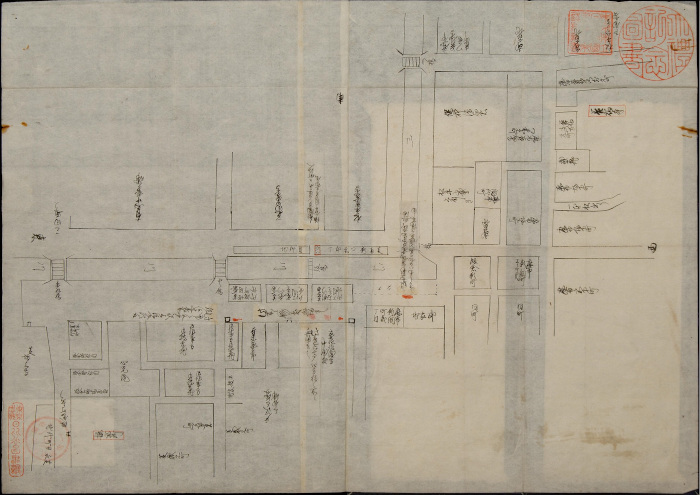
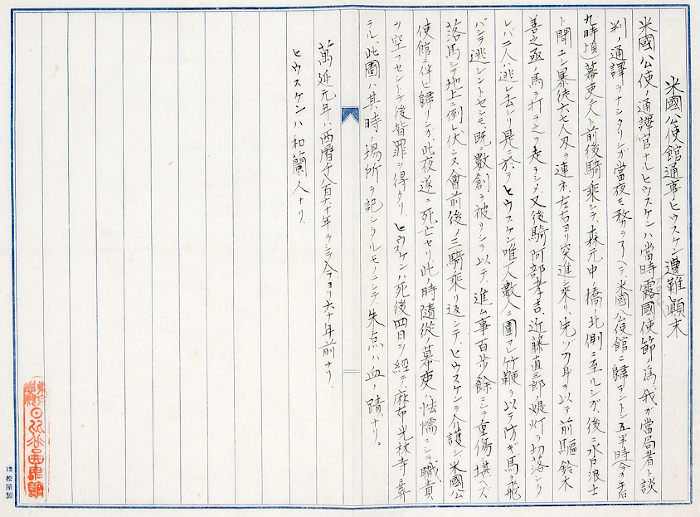
This map contains detailed information on the site of Heusken's assassination. The separate report provides a brief written account of the incident and explains that the red markings on the map are where traces of blood were found. The map itself includes comments such as "copious amounts of blood."(34×48.1cm, 24.2☓33cm)
3 From the Surrender of Edo Castle to the Procession of the Emperor to Tokyo
Having claimed victory in the Battle of Toba-Fushimi at Kyoto in January 1868, the army supporting the establishment of a new national government prepared for a full-scale assault on Edo Castle. However, following a meeting between Saigo Takamori and Katsu Kaishu in the Satsuma Domain Residence, the new government forces succeeded in achieving the bloodless surrender of Edo Castle in April of the same year. This was followed in May by the Battle of Ueno, which pitted the new government forces against the Shōgitai, a pro-Shogunate army composed mainly of former vassals of the Shogun. The new government made a full-on assault and annihilated their opponents in just one day.
In July, Edo was renamed "Tokyo," and in October the Emperor completed his journey from Kyoto and arrived at Edo Castle, which became the imperial palace under the new name of "Tokyo Castle." The Emperor went back to Kyoto temporarily, but returned to Tokyo in March of the following year, which marked the official relocation of the national capital.
The Surrender of Edo Castle
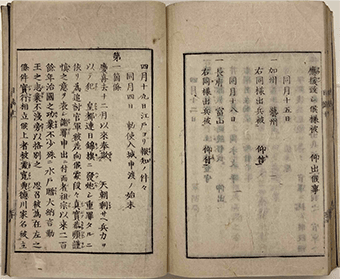
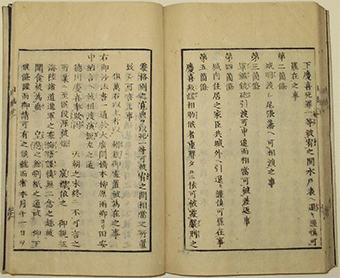
12 Gazette of the Council of State
Tokyo Shiryō Collection 1574-5
The Gazette of the Council of State (dajōkan nisshi) is the predecessor of the present-day Government Gazette, issued in the first year of Meiji period. On April 4, 1868, in advance of the surrender of Edo Castle, Hashimoto Saneyana and Yanagiwara Sakimitsu entered the castle as imperial envoys. The extract from the Gazette shown here is the text of the imperial decree that the envoys brought to the castle. Its orders included the punishment of Tokugawa Yoshinobu and the handover of Edo Castle. (21.2×14.7cm)
13 〔Letter from Katsu Kaishū to Yamaoka Tesshū〕
Watanabe Tōsui Collection of Letters 3449
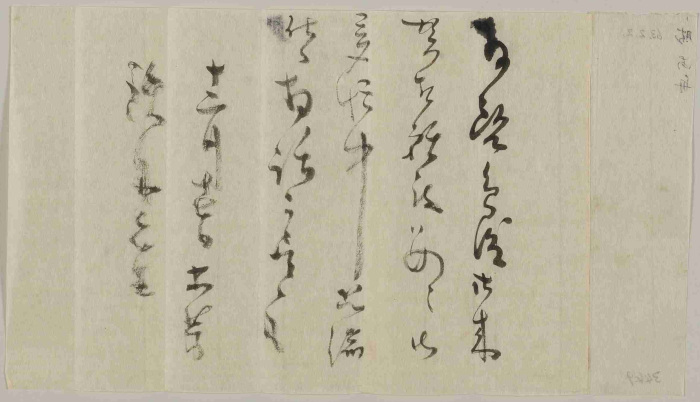
Katsu Kaishū and Yamaoka Tesshū were vassals of the Shogun who strove to ensure that no blood would be shed in the handover of Edo Castle.
In this letter, Katsu asks Yamaoka to visit him because he has something to discuss. (16×24.5cm)
14 Depiction of Children's Game for Boy's Festival
New Acquisitions WA-BE177
This is a satirical depiction of the surrender of Edo Castle that draws on the traditions of the Boys' Festival. The identities of individuals and their domains are implied through symbols such as patterns on their clothing. On the right side is the allied army led by the Satsuma and Chōshū Domains (part enlarged image). Inside the building is the Shogun Yoshinobu and Tenshō-in, as well as Tayasu Kamenosuke (later to become Tokugawa Iesato), who was under Tenshō-in's protection. (37.2×49.8cm)
The Battle of Ueno
15 Famous Places: Ueno
Tokyo Shiryō Collection 0461-C12
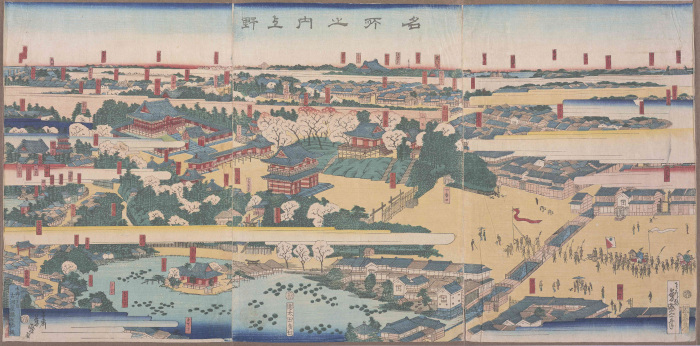
This illustration is said to depict the army of the new Meiji government marching toward Kan'ei'ji Temple on April 19, 1868, around six weeks before the Battle of Ueno. The plan to redirect the army to Kan'ei-ji Temple was prompted by concerns over the movements of the anti-restoration Shōgitai forces barricaded in the Temple. The government army displayed a flag identical to the imperial ensign and brought rifle troops and cannons to the negotiations, sending a clear message of warning to the Shōgitai. (35.8☓73cm)
16 The Great Battle at Kan'ei-ji Temple in Ueno, May 15, 1868
Tokyo Shiryō Collection 1584-D1
This colored woodblock print depicts fighting during the Battle of Ueno. It gives a sense of the overwhelming difference in military capacity between the two sides, with the cannons and rifles of the new Meiji government army countered by the Shōgitai mainly using swords and spears. The top right corner of the illustration shows townsfolk fleeing from the battle, while in the lower left corner the chief priest of Kan'ei-ji Temple, Rinnōji-miya(part enlarged image), is shown escaping, disguised in a straw rain cape and broad-brimmed hat. (41.9×248.8cm)
17 Map of Areas Destroyed by Fire around Kan'ei-ji Temple
Tokyo Shiryō Collection 1584-C28
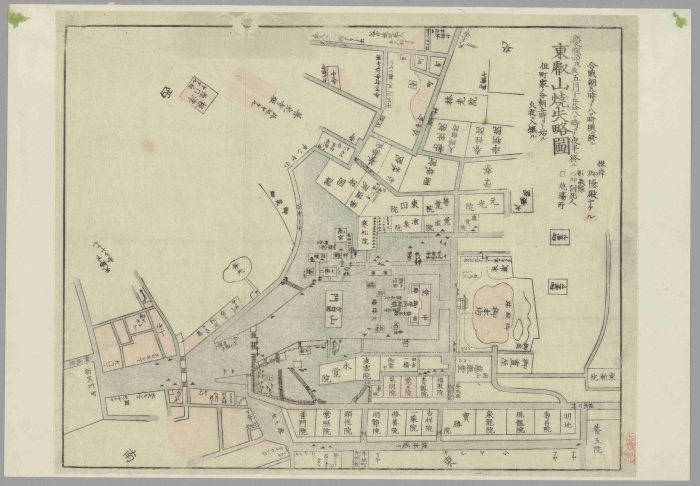
The Battle of Ueno caused fires that not only destroyed many of the buildings in Kan'ei-ji Temple, which had been much loved by the Edo townsfolk, but also burnt down numerous dwellings in surrounding districts such as Shitaya and Yanaka.The areas painted in pink on the map represent burnt areas,while triangle marks represent the points where soldiers of the Shōgitai were killed. Although the battle was over in a single day, both the new government army and the Shōgitai suffered numerous deaths and casualties.(26.6×33.7cm)
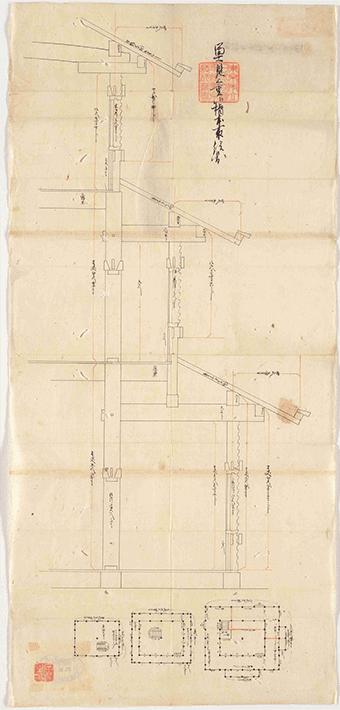
18 Dimensional drawing of Fujimi Three-Story Turret
【The Important Culture Property】Tokyo Shiryō Collection 6192-23
After the destruction of the donjon of Edo Castle in the Great Fire of Meireki in 1657, Fujimi Three-Story Turret is said to have been used as a substitute, owing to its great height and imposing appearance. Ōmura Masajirō, who masterminded the elimination of the Shōgitai in the Battle of Ueno in May 1868, is said to have watched the flames rising in the Ueno district from this turret and gained assurance that the Shōgitai had been vanquished. (78.5×36.5cm)
The Procession of the Emperor to Tokyo
19 Illustrations of Nakabashi-dori Street in Tokyo, No. 2: Kyobashi Bridge
Tokyo Shiryō Collection 155-C12

This colored woodblock print depicts the Meiji Emperor and his entourage arriving in Edo for the first time on October 13, 1868. Preceded by a western-style drum and fife band and high-ranking government officials on horseback, the palanquin bearing the emperor is shown here passing over the Kyobashi Bridge. Separate records confirm that the imperial army flag was borne at this time by sumo wrestlers, so it is likely that the artist of this illustration actually witnessed the events in person. (42×155.4cm)
20 〔Emperor's Gift of Sake to the People〕
Tokyo Shiryō Collection 5247-C13-1
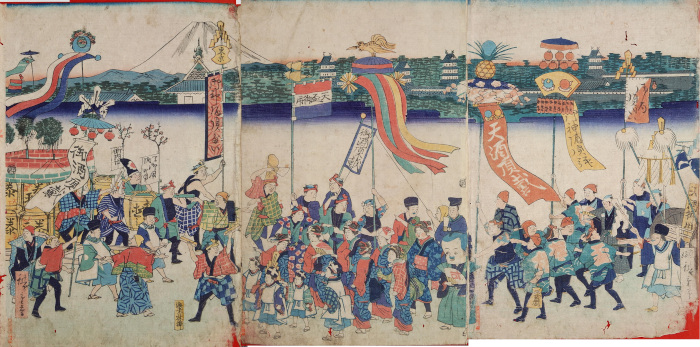
Government officials thought it necessary to have the Meiji Emperor bestow his "blessings" on the people of Tokyo, in order to rid the city of anti-government sentiment. On November 4, 1868, while the Emperor was visiting Tokyo, some 3,000 barrels of sake (rice wine) were distributed to neighborhoods all over the city. Each neighborhood devised its own parade to transport the barrels through the streets in a festive spirit. (36×72cm)
